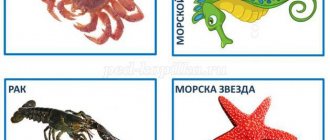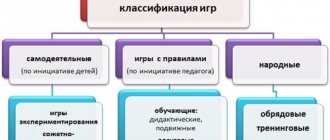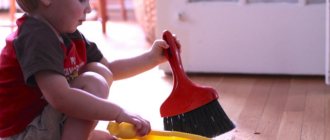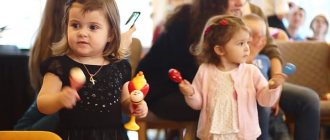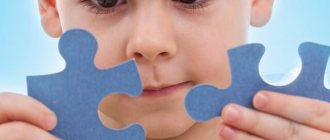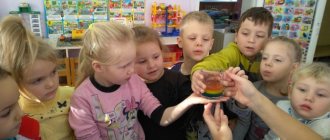Visual methods
The name speaks for itself - the main way to acquire information is through vision. Teaching techniques and methods involve the use of illustrations and specific images. These include:
- Illustration. The essence of this method lies in the use of various visual objects in teaching and raising children, namely paintings, pictures, posters and other teaching aids. For the development of preschool children, pictures with plants, animals, equipment, household items, and the like are often used. Often images of the objects being studied are used (photos, paintings, three-dimensional models). They work with children of senior preschool age using schematic images (graphs, diagrams, tables, maps). This method helps to form concrete ideas and precise concepts.
- Demonstration. The point is in using instruments and conducting experiments. The effectiveness of this method lies in the fact that preschoolers focus their attention only on the main thing, without being distracted by minor details. The teacher is faced with the task of creating the most comfortable conditions for considering the subject, highlighting only the main thing, thinking through a clear story and involving children in searching for the necessary information.
- Observation. The point is the perception of reality. An educational institution can organize observation both during class or excursions, as well as during free time. Using this method, children learn to analyze, compare and draw conclusions.
Methods and techniques to help organize children in the classroom.
When planning GCD, I note in advance what methods and techniques I will use in the lesson. The attention of the four-year-old children with whom I work is not yet stable. To ensure a lasting assimilation of knowledge, they must be interested in work. It is necessary to regulate the employment of children. Children quickly become fed up and become very tired of activities that they have to perform under duress. Also, students can become overexcited from the abundance of stimuli.
Visual methods and techniques
The main principle of children's thinking is the principle of clarity. Therefore, in my classes I use visual methods and techniques that will ensure the high efficiency of the educational process.
Observation 1. Recognize, determine characteristics.
—in classes on the surrounding world while studying the topic “Flowers”, I propose to look at various plants and name only the flowers;
-in classes on speech development when studying the topic “Sound”, I suggest watching me, my pronunciation (how my lips are positioned, whether something prevents me from pronouncing the sound in a drawn-out manner).
2. Determine the nature of changes or transformation of an object.
For example:
- during classes on the surrounding world when studying seasonal changes in plants - the children and I make observations on a walk about what happened to the trees in the fall; We analyze visual information in routine moments during classes.
-in mathematics classes when studying the number 3 - establish what will change if you add another one to two subjects, this is necessarily visual information.
3. Establish the state of an object based on individual characteristics.
For example:
- during classes on the surrounding world when studying the topic “Parts of the day” - determine by the state of the sky and the position of the sun which part of the day has arrived;
- during classes on the surrounding world when studying the topic “Animals” - determine who it is by the type of paws (tail or ears).
Demonstration
A demonstration is a visual display of an object. No verbal explanation in kindergarten classes will be effective if it is not accompanied by the demonstration of various visual aids. To get children interested in the topic of the lesson, I use a demonstration before the lesson:
- objects, natural objects;
- subject or didactic pictures;
-book illustrations;
-reproductions;
-layouts.
The demonstration method covers the following teaching techniques:
-Demonstration of items. I often use such methodological techniques in art classes. For example, before offering to draw an apple, I immediately show it to the children and suggest that they take a good look and describe its shape, size, and color.
-Sample demonstration. For example, I show children a sample of the application that they will perform or a sample of writing letter elements, etc.
-Demonstration of illustrations and reproductions. This technique is used when there is no possibility of direct perception of the object. For example, when studying the colors of the rainbow, if it is not in the sky at that time, I show the children a picture in a book.
Practical methods and techniques
Practical methodological techniques in kindergarten classes help preschoolers to more deeply understand the surrounding reality. Practical methods provide a higher degree of knowledge acquisition than any other didactic techniques. A child will remember much better that lemon is sour if he tastes it himself, etc. There are four main methods.
Exercises
-Exercises are the repeated repetition of various actions (practical or mental) of a certain content.
Experiment
In kindergarten we practice only the simplest experiments that help children gain new knowledge about the environment. During the experiment, preschoolers interact with objects to learn their properties and relationships with other objects.
I suggest the following tasks:
- determine which object sinks and which does not;
- turn snow into water;
-conduct experiments with clay, etc.
Thanks to this method, we form visual and effective thinking in children.
Modeling
The modeling method is based on the principle of replacing a real object with a symbol, image, sign. The use of this method contributes to the development of skills to compare, abstract, and generalize essential features.
Games
During didactic games, children are asked to recreate a specific situation, “live” it and gain some experience of acting in certain conditions. The use of this method presupposes the presence of gaming equipment, the distribution of roles and the implementation of gaming actions.
The gaming method forms creative thinking, develops imagination, helps the child learn to behave at ease, and relieve psychological stress.
Verbal methods and techniques
Verbal methods provide live communication between the teacher and children.
Story or reading
A story is an effective verbal method that allows you to present information in an accessible way for children. I use literary works or create stories from personal life experiences. The story can be used during any lesson. After listening to the story, I check the degree to which the preschoolers have mastered its content.
Conversation
During the conversation, each child has the opportunity to share his opinion and experience with the entire team. We conduct conversations after listening to a literary work or watching a video.
We widely use verbal methodological techniques in speech development classes. These include:
-speech sample - I give an example of correct pronunciation, sentence construction, use of intonation, etc.;
- repeated pronunciation - a sound, word or phrase is repeated many times to assimilate or remember (for example, learn a tongue twister, remember the correct use of stress in a word);
I supplement the verbal method with visual or practical methods. This promotes the development of children's speech, creative imagination, and cognitive activity.
In my classes with children I use a variety of methods and techniques, alternating and combining them. At the same time, I conduct a “live” dialogue with the kids, encourage them to take direct action, and rely on children’s life experience. Such conditions for the educational process in kindergarten will ensure its high efficiency.
What is the method and technique of teaching?
A teaching method is a way of interaction between an adult and a child that helps to effectively solve educational problems.
Pedagogical teaching techniques are one of the components of the method, the action of which realizes it fully. It is important to be able to separate the methods of mental activity from the methods of educational work. The mental techniques of child development are the same in different modes of interaction. Only their correct combination has a development effect, and, based on this, it is very important to apply them in a certain sequence. Identical techniques can be used in any teaching method, but in interaction with other techniques they create a completely different method. For example, a technique such as memorization is used in both reproductive and problem-search methods. But in the first case it is the main one, and in the second case it is secondary.
Teaching techniques and methods can be subjective or objective. Objective ones are guided by preschool didactics. But the subjective part of the method depends on the skill of the teacher.
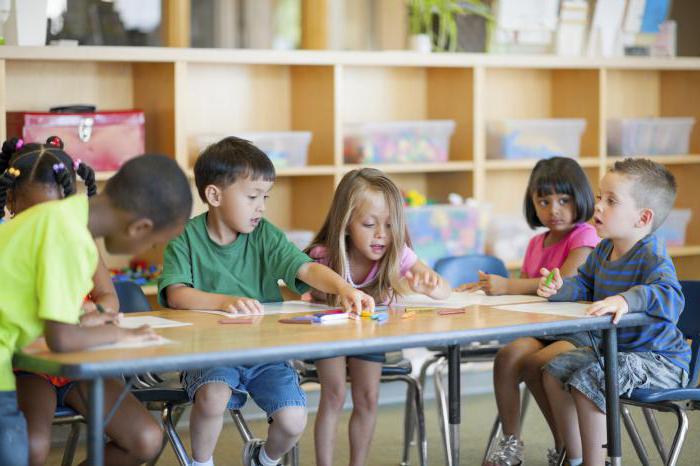
Classification of teaching methods
Classification of teaching methods
The success of education and training largely depends on what methods and techniques the teacher uses to convey certain content to children, develop their knowledge, skills, and abilities, as well as develop abilities in a particular area of activity.
Methods of teaching visual activity and design are understood as a system of actions of a teacher who organizes the practical and cognitive activities of children, which is aimed at mastering the content defined by the “Program of Education and Training in Kindergarten.”
Teaching techniques are the individual details, components of the method.
Traditionally, teaching methods are classified according to the source from which children acquire knowledge, skills and abilities, and according to the means by which this knowledge, abilities and skills are presented. Since preschool children acquire knowledge in the process of direct perception of objects and phenomena of the surrounding reality and from the teacher’s messages (explanations, stories), as well as in direct practical activities (construction, modeling, drawing, etc.), the following methods are distinguished:
- visual;
- verbal;
- practical.
This is the traditional classification.
Recently, a new classification of methods has been developed. The authors of the new classification are: Lerner I.Ya., Skatkin M.N. it includes the following teaching methods:
- informative - receptive;
- reproductive;
- research;
- heuristic;
- method of problematic presentation of material.
The information-receptive method includes the following techniques:
- examination;
- observation;
- excursion;
- example of a teacher;
- teacher demonstration.
The verbal method includes:
- conversation;
- story, art history story;
- use of teacher samples;
- artistic word.
The reproductive method is a method aimed at consolidating the knowledge and skills of children. This is a method of exercises that bring skills to automaticity. It includes:
- reception of repetition;
- work on drafts;
- performing form-building movements with the hand.
Heuristic method
is aimed at demonstrating independence at some point during the lesson, i.e. The teacher invites the child to do some of the work independently.
Research method
is aimed at developing in children not only independence, but also imagination and creativity. The teacher offers to do not just any part, but all the work independently.
Method of problem presentation,
according to didactics, it cannot be used in teaching preschoolers and younger schoolchildren: it is applicable only for older schoolchildren.
In his activities, the teacher uses various methods and techniques in drawing, modeling, appliqué and design.
So in drawing, the main technique for the first junior group is to show how to use pencils and paints. The most effective technique is passive movements, when the child acts not independently, but with help. Playful visual movements of a homogeneous, rhythmic nature with the pronunciation of words: “here - here”, “up and down”, etc. are effective. This technique makes it possible to connect the image of an object with pictorial movement.
Reading poetry
, nursery rhymes, songs in the classroom - the most important methodological technique. Another method of working in the first junior group is co-creation between the teacher and the children.
In the second junior group, the information-receptive method is actively used in drawing classes .
An effective way to become familiar with the shape of an object before class is especially useful: children trace the shape with their hands, play with flags, balls, balls, and feel their outlines. Such examination of the subject creates a more complete picture of it.
Also effective is the technique of examining an object by moving your hand along the contour and showing this movement in the air. Direct demonstration of the image method is used only if this form is encountered for the first time. In all
Methods and techniques for teaching speech in kindergarten
Concept of speech teaching method
The principles of mastering native speech, as already mentioned, are that speech is learned intuitively (unconsciously) in the process of developing a number of abilities: 1) the ability of a person to force the muscles of his speech organs to work - to articulate speech sounds, modulate elements of intonation, prosodemes and hear them; 2) the ability to correlate complexes of sounds and intonation with extra-linguistic reality, that is, to understand them as semantic elements of speech; 3) the ability to correlate the semantic elements of speech with one’s feelings, i.e., evaluate them; 4) the ability to remember the tradition of combining semantic and evaluative elements of speech in the process of communication, cognition, speech regulation and planning of human behavior. A child’s speech is enriched faster and his psyche develops more comprehensively if educators place him in conditions where natural speech activity is more intense. The main condition for accelerating the development of speech activity is the use of various methods of teaching speech, built on the principles of linguodidactics. A teaching method refers to the actions of the teacher and the learner, performed with the aim of transferring knowledge from one to another. The preschool period of speech development is characterized by practical methods: the imitation method, the conversation (conversation) method, the retelling method, the storytelling (composition) method.
Simulation method
The imitation method consists in the fact that both the teacher and the student both say the same thing, but speak differently: the teacher articulates the sounds of his speech somewhat more energetically than in a conversation with adults and intones his speech expressively, and the student listens and repeats, imitates his speech, tries to master speech movements (articulations and modulations of the voice) and understand the meaning (correlate these sound complexes with designated objects, actions, etc.). At the same time, it is important for the teacher to stay at the level of the orthoepic norm and not to imitate the child’s pronunciation himself (not to “lisp”, not “to lisp”). This method begins to be used at the earliest age level and continues at all subsequent ones (not only in kindergarten, at school, but also in adulthood). Learning by imitation can occur involuntarily in the process of communicating with a child while performing household procedures, for example, while bathing a child. - Where is my daughter’s hand? - says the mother, emphasizing the word hand in her voice and touching the child’s hand. - Here's a hand! Oh, what a hand!
By this time, the child will have learned the general meaning of the word hand, that is, he will understand that this word refers not only to his hand, but also to the hands of his mother, grandmother, and doll. The imitation method is used in teaching speech to children and older children, practically during any game. During object games, children move, throw, show, push, feel, turn on, observe objects and name their qualities and actions. In this case, the teacher must talk to the child and ask him leading questions. “What kind of ball is this? small? blue?”, “Is this car moving? stopped?”, “How does the car honk? locomotive? steamboat? - asks the adult. The child, answering, repeats what the teacher suggested in his question: “Little”, “Rides”.
This expands the child’s vocabulary. Helping the child “build,” the teacher names the object they are building, its parts, and names his actions necessary to achieve the result of the construction. For example, a child, with the help of an adult, assembles a car from “constructor” parts. - What will we build, Lenya? Automobile? Which? Volga or truck? - Truck. - First we need wheels. Please give me the wheels, Lenya. What did you bring? - Wheels... brought. - Very good. And here is the frame. Let's put the frame on the wheels. Now let's install the cabin... The engine, hood, steering wheel, and body are also searched for and installed in place. By naming the parts of the car and the actions he performs when assembling the car, the child imitates the speech of the teacher. Especially many favorable situations for the development of speech develop during plot games - role-playing, “director’s”, dramatization. In the game, the role-playing child copies various situations from the lives of adults that he observed or about which he knows from stories and remembers: “a mother feeds the children,” “a tractor driver plows a field,” “an electrician or a gas worker, or a plumber came to the apartment on a call from the residents,” “a teacher teaches children at school”, “an astronaut flies to the moon”, etc.
The child copies both the actions of adults and the speech with which they accompany their actions.
The child repeats (imitates) this phrase and thereby learns grammar: the use of nouns in the genitive case. In a dramatization game, the child takes on the role of one of the heroes of a familiar fairy tale; during the game, he repeats the words of his hero and thereby enriches his speech. Here is six-year-old Tolya playing with his younger sister Zhenya (2 years 10 months) “Little Red Riding Hood and the Gray Wolf.” He, of course, is the wolf and the hunters, and she is Little Red Riding Hood. Story-based games serve as an excellent exercise for children to consolidate acquired language material. Children deliberately set themselves the goal of accurately conveying the speech of an adult heard in a certain life situation, or the speech of a hero in a fairy tale. Outdoor games and games according to the rules enrich children’s speech with memorized nursery rhymes, songs, and rhymes. Memorization occurs in the process of imitating the speech of the teacher, who plays with the children and first recites nursery rhymes, rhymes, and sings songs. The extent of a child’s verbal participation in play depends on his age. For example, “Ladushki”, which children play in the first year of life, is accompanied only by the speech of an adult; the child imitates only his actions (claps his hands, puts his hands on his head, etc.). But three-year-old children, playing “loaf”, can not only sing with the teacher “We baked a loaf...”, but also repeat after him the rules of the game: “Stand in a circle!” Join hands! Let's go in circles! Everyone sit down! Everyone stood on their tiptoes, hands up! Expand the circle! Close the circle! Older preschoolers can play outdoor games on their own, distributing roles by lot and counting.
Reception training
Above are examples of teaching using the same method - the imitation method. But in each case this method was carried out using different techniques. Technique is a variant of using this method, introducing into the main action that makes up this method side effects suggested by the nature of the educational didactic material. Thus, the techniques by which the imitation method is implemented can be: 1) observation of a real object while becoming familiar with the surroundings - in the case described above, the baby examines his hands, watches his mother’s hands and at the same time repeats after her, imitates her speech;
2) games: in the process of games, as we have seen, the child’s speech is enriched not only with new vocabulary, but also with word forms that are new to him (the game “electrician”, “visit”, when children master the genitive form of the noun, “Little Red Riding Hood” and the wolf”, during which children become accustomed to coherent dialogical speech); 3) relying on a verbal model (verbal presentation): children repeat the phrase uttered by the teacher (“Water, water, wash my face!”). So, we got acquainted with the method of imitation, which consists in the fact that the teacher and the student both say the same thing, but the teacher shows an example of how to speak, and the student repeats it exactly and imitates it. The techniques by which the simulation method can be performed are described above. But there are a huge variety of techniques for implementing any method: every creative educator always creates his own techniques without violating the method itself. Thus, the imitation method, in addition to the techniques described, can be performed by using pictures, living objects (animals, plants), filmstrip, tape recorder, etc.
Conversation method
A more difficult method of teaching speech to a child is the conversation method, it is also called the question and answer method, the conversation method. The conversation method is that the teacher asks and the student answers. Consequently, both of them speak, but they say not the same thing (as with the imitation method), but different things: with his question, the teacher encourages the child to remember the words, sounds, grammatical forms or coherent text already known to him and to use them appropriately. To train the speech organs of children of the third year of life in the articulation of sounds [g] - [z], the teacher can use different techniques of the conversation method.
1. - Sasha, do you remember how the beetle buzzes? - asks the teacher. The boy remembers: - He... w-w-w... - How does a mosquito itch? — the teacher prompts the boy to articulate a similar sound. - Mosquito... s-z-z... This is a technique of relying on a verbal representation (presentation of a verbal sample). 2. For the same purpose, you can use the technique of a plot role-playing game: - Zina, Sasha, Kolya! You will be beetles, and you, Sema, Nina, Masha, will be mosquitoes. Well, fly towards each other and buzz or itch. Consolidating an understanding of the meaning of a word, such as vegetables, can be done in different ways. 1. The teacher takes the children to the kitchen, where vegetables are laid out on the table especially for this purpose, and asks everyone: “Do you see what is on the table?” Children list what they see: - Carrots... cucumbers... tomatoes... eggplant... - What do they call all this together in one word? “These are vegetables,” one of the children hastens to say. “That’s right, these are vegetables,” the teacher encourages the boy. - What other vegetables do you know, besides those that are here? “Zucchini is a vegetable,” says the girl. “Cabbage, potatoes, turnips, onions, garlic are vegetables,” someone else adds... As you can see, in this case, the already familiar method of observing real objects was used, but the method was new - the method of conversation.
2. Instead of real vegetables, the teacher can use pictures depicting various vegetables, that is, use the technique of relying on the picture, but this will also be a conversation method.
The method of relying on a picture can be complicated, for example, by introducing the word fruit for comparison. In this case, a question for children could be as follows: “Children, here are pictures depicting vegetables and fruits.” Which one of you will be quicker to sort them into two piles: vegetables - to vegetables, fruits - to fruits? Of course, such work can be organized if there is appropriate handout: each child should receive a set of pictures. The method of relying on real objects or pictures borders on didactic games, that is, games specifically designed for learning. Adults first introduce children to the rules of a particular game. Then they are given the opportunity to play on their own. Any didactic game contains great opportunities for the development of a child’s speech: after all, any knowledge that a didactic game gives is acquired by the child in verbal form. But there are didactic games specifically designed for the speech development of children - these are the so-called verbal didactic games.
These games consist of children: 1) coming up with words for a given sound: - Indicate objects whose names begin with the sound [s]. — Table, chair, wall, shelving; 2) name objects according to the adult’s description, guess simple riddles: - Bring me something that has a lot of pieces of paper filled with letters, something that is painted with pictures. - Bring me something where I can learn a fairy tale or poetry. Children bring a book. Such descriptions, of course, are offered to children five or six years old; “Guess what it is: “Small, but distant: he passed through the earth - he found a little red riding hood,” says the teacher when he collects mushrooms in the forest with the children or just walks with them through the forest. 3) ask riddles known to them or come up with riddles themselves. The basic rule of the didactic game: children must see (or better yet, touch, smell, taste, hear, if it sounds) the object about which the riddle is being made.
In order for children to master the construction of a common sentence, for example a two-part sentence with a direct object, it is necessary to use various techniques (conversation method) depending on the age of the children. For the fifth year of life - a method of relying on verbal representations (conversation method). - Children, let's play “Who is bigger?”
When working with children of the fourth year of life, the solution to the same problem should be facilitated by using the technique of relying on a picture (conversation method). We need a set of pictures depicting a person with an attribute of his profession: a cook at the stove, a gardener with a shovel, etc. When working with children six to seven years old, the conversation method is complicated by the fact that, firstly, a more complex syntactic form is specified (the spread of a simple sentences in isolated phrases or composing a complex sentence), secondly, the range of vocabulary expands. For example, the teacher begins the game by giving an example: “The astronauts who carried out observations of the Sun landed safely in Baikonur.” Children replace the participial phrase in this sentence with their own: those who made observations of the ocean, the northern lights, the stars, the taiga... (the teacher can suggest the objects of “observation” to the children, but they themselves must concentrate their efforts on the correct construction of the sentence). Another sample proposed by the teacher: “Hunter-photographers, tracking the animal, walked (made their way) for a long time after it through the forest with a camera.” Children learn to use imperfective participles in speech, build the same syntactic construction that is given to them in the model, replacing the abstract word beast with a specific name: “chasing a bear (elk, deer, tiger, etc.).” To practice coherent storytelling, the teacher, having outlined a topic, can organize the children’s speech by posing several questions (points of the plan) that develop this topic. For example: - Slava (6 years old), did your Rex accompany you to kindergarten this morning? Did he bark at passersby? How does he walk down the street? Who took him out for a walk today? (The teacher, of course, must be aware of the affairs of Slavik’s family in order to pose these questions to him.) For a four- to five-year-old child, questions should not be asked all at once, but one at a time: call him to dialogue. So, the conversation method is a method of teaching speech, which consists in the fact that the teacher encourages the student to appropriately use his speech reserve and thereby improve his speech. The conversation method can be performed using the same techniques as the imitation method (the technique of observing real objects, relying on a picture, a verbal model, techniques of various types of games), as well as techniques for asking various questions and tasks. The conversation method should not be identified with the school conversation method, which is one of the ways of presenting theoretical material; the conversation method, as can be seen from its description, is a practical method.
Retelling method
Preschoolers of the fifth to seventh years of life are taught speech, in addition to the methods described, by the method of retelling, which enriches their speech with all components of the language (vocabulary, grammatical forms, intonations), training their coherent speech. The retelling method consists in the fact that the teacher reads (tells) a work of art to the children or reminds them of what they saw together on a walk, on an excursion, or tells an “incident from his life” (narration), or gives a verbal description of something an object, an animal that the children have not seen, and encourages them to want to: 1) ask questions during the teacher’s story, 2) repeat his story (for one of their friends or at home for adults). The retelling method is similar to the imitation method. The difference between these methods is that the child imitates (repeats) parts of the text that the teacher has just spoken; the child retells, if possible, the completed text that he heard the day before; Some time must pass between the child’s perception of the text and its retelling.
The methodology has developed many retelling techniques related to introducing children to fiction, for example: playing favorite characters, dramatizing fairy tales, short stories, etc. Composition (storytelling) method
The greatest independence in speech is provided to preschool children by the method of composing (storytelling), which consists in the fact that the teacher encourages children to independently “compose” fairy tales, tell them real incidents from their lives, mix (mix) themes from the fiction they read, and describe them pictures, real objects - things, animals, plants.
Concept of practical method and technique
All of the methods described above for teaching children their native speech involve mastering speech in natural, live communication, when the child does not even notice that he is being specially taught and learns speech intuitively. Such methods are called practical teaching methods, in contrast to theoretical ones, with the help of which children and adolescents are taught information about linguistics - the science of language. Children become familiar with theoretical methods at school after they have mastered their native language practically. A professional skill for a future teacher is the ability, and then the skill, to impromptu (that is, without prior preparation) conduct a meaningful (developmental) conversation with children - with an individual child and with a group. This skill is acquired as a result of mastering the appropriate methodology - mastering practical methods. The ability to call children for a conversation, for a coherent story, is also acquired, which turns into a skill. The teacher must be prepared to enter into a meaningful conversation with children: in the process of everyday activities (during the morning meeting in kindergarten; in preparation for meals, in the washroom, during meals; in preparation for bed; giving them household items). and other instructions, etc.); on walks and excursions; during games; when considering pictures, transparencies, code positives; in the process of work, while reading and discussing works of fiction, etc.
Practical teaching methods:
imitation, conversation (conversation), retelling, storytelling (composition) - and methods of working with these methods: relying on real objects, relying on games (subject, plot, mobile, didactic), relying on illustrations (pictures, slides) , reliance on verbal samples of the teacher’s speech, video views, presentations - are effective in teaching children speech because they
are built taking into account the laws of the natural process of speech acquisition, do not disrupt this process, but only make it more intense, rich in speech work - physical, muscular, and internal, intellectual and emotional.

